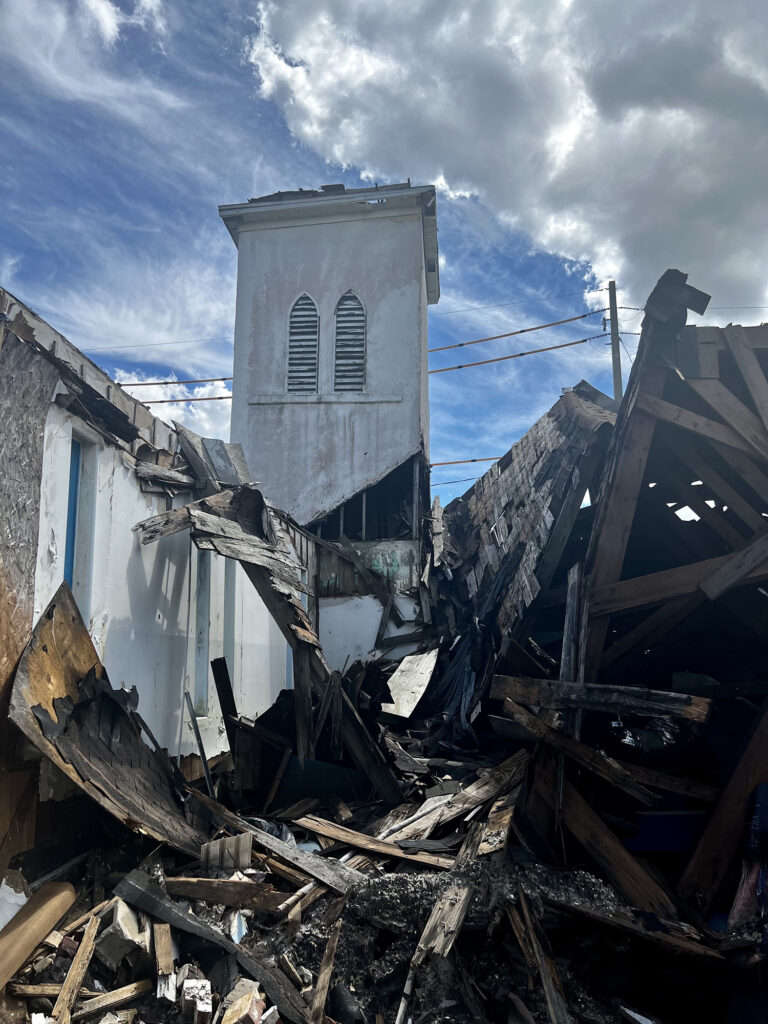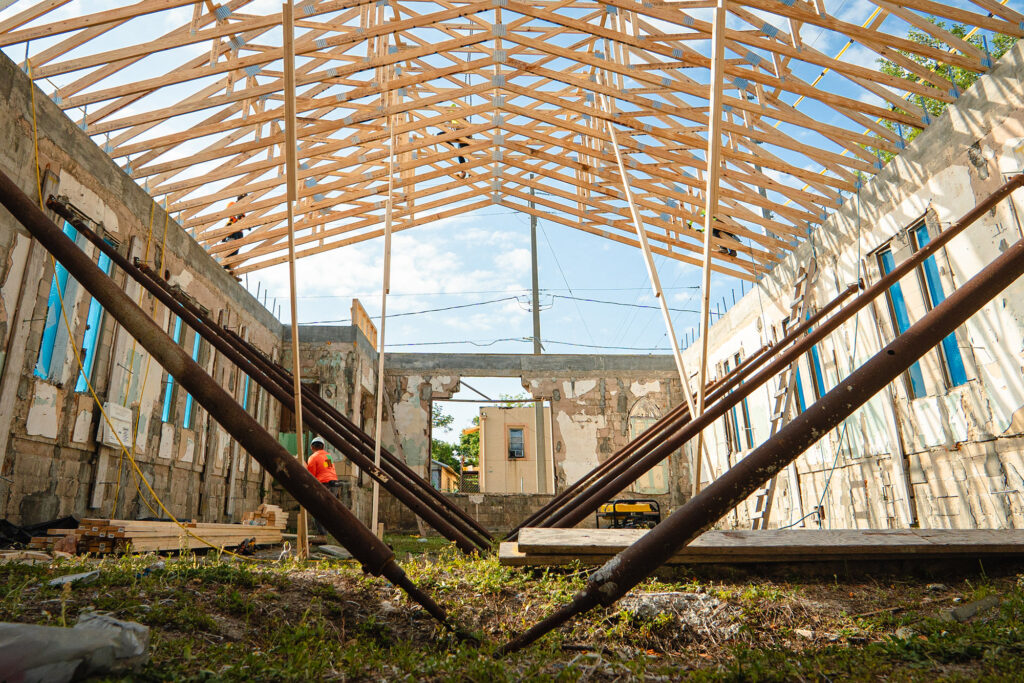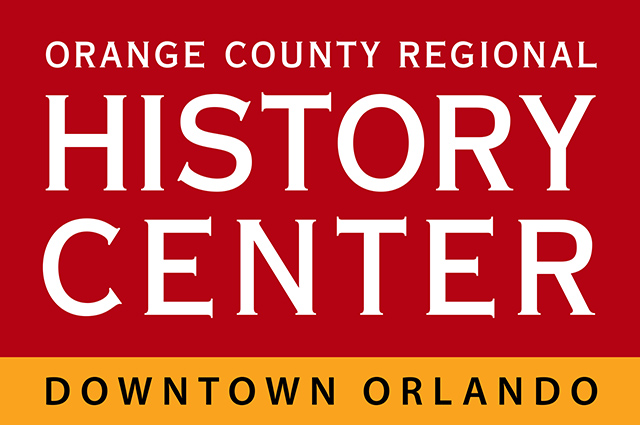A century-old church in Parramore becomes a rallying point for preservation, partnership, and neighborhood renewal.
By Susan Moynihan from the Fall 2025 edition of Reflections Magazine
Driving a friend home in Orlando’s Parramore district in 2015, Pastor Dana Jackson wasn’t thinking about buying real estate. Her son had recently died, and the minister was deeply grieving the loss. But when she saw a rundown church on the corner of Westmoreland Drive and Bentley Street, something clicked.
“When I saw the church, it grieved my spirit,” she says. “Who would just let a church just go down like that?”
The Spanish Mission-style church was a shadow of its former self, with holes in the red tile roof, crumbling stucco walls, and a deteriorating interior. It hadn’t always been that way. Built in the mid-1920s by a group of Parramore residents, the former Pleasant Hill Colored Methodist Episcopal congregation (later renamed the Carter Tabernacle CME) was once a staple of a thriving Black community in downtown Orlando.

After Pastor Jackson had purchased the decaying Parramore church, water and wind damage added to the structural instability of the building, collapsing the northern gable and causing irrevocable damage. Image courtesy of Interstruct Design + Build.
A community at risk
But headwinds were brewing from the church’s very foundation. Around that same time, city developers began to enforce segregation by using zoning laws to designate residential areas for Black residents, in places with less-desirable geography and poorer infrastructure.
The advent of integration in the 1950s created additional challenges, says Walter Hawkins, the former director of urban development for the City of Orlando Community Redevelopment Agency, who grew up nearby. “Integration meant that most of your community should be bussed out to other areas, with Black people going to integrate white schools. But white folks were not coming to integrate Black schools,” says Hawkins. This led to the consolidation and closure of schools in historically Black neighborhoods such as Parramore.
“For a long period of time, there was not an elementary school; they had closed two of the major elementary schools in the late ’50s and early ’60s,” Hawkins says. The closures helped lead to a furthering fracturing of community; when children no longer lived down the street from the kids they went to school with, their families had fewer social ties to bond them.
The segregation was further geographically enhanced in 1962, when the construction of Interstate 4
cut off part of Division Street, effectively severing Parramore from the city center just a mile to the east.
Middle-class Black families began to depart for areas with more to offer, from schools to infrastructure such as grocery stores. And while these families often came back for church services, it wasn’t enough. “People were driving into the neighborhood to attend church, but after church was over, they left, going somewhere else,” Hawkins says. “With people leaving the neighborhoods, you know, people aren’t going to be taking care of it as much because they’re living not there; they’re not as connected to it.”
As the neighborhood economics declined, the original founding parish moved to a new church in the Washington Shores neighborhood, a few miles southwest of Parramore. A later congregation renamed the building Black Bottom House of Prayer, paying tribute to the neighborhood’s original nickname of Black Bottom, after the muddy streets caused by constant flooding from low elevation and the lack of an area drainage system. Eventually that congregation moved too, and the church sat vacant, another overlooked building in an overlooked neighborhood.

After navigating permits from the City of Orlando, Interstruct Design + Build stabilized the church’s perimeter walls to complete the demolition and remove the debris. Then a new scissor roof truss was installed. Image courtesy of Interstruct Design + Build.
A leap of faith
Looking at the church on that day in 2015, Jackson was reminded of a conversation she’d had with her son about gentrification. “I had a radio ministry at the time, and someone called in and said, ‘Pastor Jackson, the city is buying up all the property, and gentrification is pushing all the poor people out,’” she says. “My son was special needs, and he said, ‘Mommy, what do they mean by gentrification, pushing all Black people out?’ He didn’t understand.” After her son passed away and she received a financial settlement in his name, she decided to use the money for a greater cause. “The Holy Spirit said, buy that church that grieved your spirit because you can continue his legacy,” she says.
Jackson envisioned the restoration of the decaying church acting as a living example of the power of faith. “A lot of us, we’ve been through unemployment, stress, anxiety, whatever the situation may be. There’s been a collapse in our life . . . and essentially, we need stabilization,” she says.
The first step was to get the church designated as an official Orlando Historic Landmark, which Jackson accomplished in conjunction with the Byrd Law Group and the Orange Preservation Trust. She moved her nonprofit, the National ADHD Foundation, into a newer community room that had been built adjacent to the historic church and led fellowship services to grow her congregation as she tackled securing funds for restoration. Working out of the damaged church was intentional, she says, to show the neighborhood “we’re not abandoned; there’s no for sale sign.”
A friend of Jackson’s who had recently lost his home moved into the back of the church, as a deterrent against squatters and break-ins. But just as Jackson’s cause was gaining recognition and support, the roof collapsed dramatically in December 2019 after years of water damage, fueled by hurricanes. Thankfully, no one was injured.
The former church was now in worse shape than ever, with an estimated $1 million needed to save it. Many people told Pastor Jackson it couldn’t be saved; she should just tear it down. For her, that wasn’t an option.
Jackson’s perseverance led to a $500,000 grant from Florida African American Cultural and Historical Grants, with the caveat that she secure a general contractor who would be responsible with the funds and work within the parameters of historic preservation. “I had been praying for the Lord to give me wisdom and put the team together for me,” she says.
Enter Ryan Young and Interstruct Design + Build, an Orlando-based architecture and commercial construction company. CEO and co-founder Young had become part of the Parramore community in 2020, when he and his business partner Rich Monroe purchased a parcel of land at Lee Avenue and West Church Street as the foundation for their company headquarters. Their in-house architecture team began the process of transforming the lot’s existing 1940s and 1980s structures into the company’s new home.
“I’ve always been fascinated by neighborhoods whose stories are embedded in their buildings,” says Young. “Some of the buildings in Parramore whisper the history of one of Orlando’s oldest Black communities. When the chance came up to relocate, . . . I realized we could do more than renovate a single structure – we could demonstrate how careful, incremental infill can reignite a whole corridor. That headquarters project has since won design awards and, more importantly, has encouraged other small-scale investors to look west of I-4 with fresh eyes.”
The company worked out of the office before the renovation was complete. During that time, they set about becoming a true part of the greater Parramore community.
“I went in believing great architecture should serve its block, but once we opened our doors, the real work began: listening,” he says. “The Unity Mural we commissioned became a literal backdrop for food-distribution events run with the Desire Foundation; together we now move nearly 15,000 pounds of groceries a month to neighbors who live in a food desert. Parramore Arts, our ‘gallery without walls,’ turns underutilized space next to a transformer into a rotating public-art exhibit. Those partnerships weren’t on the original pro-forma – they grew organically once we were on the ground and accountable to our neighbors.”
Though their respective headquarters were just blocks apart, Jackson didn’t know Young personally. But she’d heard of him. “I read an article in the newspaper about him. I noticed that he’s involved in the community, he’s seriously going to meetings, he’s networking and meeting people.” So, she called Young’s office and made an appointment. “I sat down and shared everything that I tried to do. . . . The rest, as they say, is history,” she recalls. “He said, ‘OK, you have $500k on the table. Let’s put it to work.’ ”
Not only did Young – who is both a licensed architect and commercial general contractor – understand the work needed to renovate the building, he understood its importance to the community. “Pastor Dana didn’t just want a roof; she wanted classrooms, counseling space, and a hub for neighborhood services,” Young says. “That alignment of mission and bricks-and-mortar made the decision easy.” In addition, he offered Interstruct’s services pro bono, as a commitment to the community and the success of the project.
After navigating the permitting process, the actual renovation work began in early 2023. Interstruct’s Joe Horsch served as superintendent after Interstruct completed the stabilization and debris removal. “When I came into the project, it was essentially a bare shell,” he says. “There was no roof on it, there was nothing on the interior – it was simply just exterior walls and nothing else.”
The restoration came with unique challenges, including preserving the historic integrity of the century-old building. “The biggest challenge working on a building like that is just trying to understand how things were built 100 years ago, and meshing that together with today’s building practices,” Horsch says. Thankfully, a lot of the elements were salvageable, despite their age and mistreatment. “I just think old things were built to last longer,” he says.
During the restoration, Jackson came by daily to check the progress, sometimes leading a prayer group outside the church. Neighbors passing by would stop to ask questions, which the team was happy to answer. “The local interaction from people who live in the area, who have been in the area for a long time — they seemed to really appreciate seeing the work, someone actively working on restoring it,” Horsch says. “It was really cool to be a part of it.”
The exterior restoration took more than a year to complete. “Structurally, the building was missing half its roof and had no lateral stability,” says Young. “We installed a formed tie-beam, new concrete and rebar that shores up the 100-year-old masonry, then installed a new roof that replicates the original pitch while meeting current hurricane codes.” The roof and bell tower were finally completed in spring 2024, ahead of Black Bottom House of Prayer’s 100th birthday in 2025, as recorded on the historic marker at the church.

Crews added a new structural tie beam, concrete, and rebar to shore up the 100-year-old masonry before installing roof trusses that match the original pitch and meet today’s hurricane codes at the Black Bottom House of Prayer. Image courtesy of Interstruct Design + Build.
The work continues
Next up for Jackson is the interior renovation, which requires a new round of fundraising. She is hopeful that the deep relationships she’s formed with the wider Orlando preservation and business communities will help with the church’s community-centered mission going forward. “Now that I have their attention, I can share with them the real true needs of the community.”
Jackson was a social worker before becoming a pastor, which informs her vision. Along with the church services, music lessons, after-school tutoring and the work of the National ADHD Foundation, she aims to offer services that aren’t traditionally available at other churches, including mental health counseling.
Her excitement is palpable as she imagines the help she can offer to her community and beyond. “Church is where you’re supposed to get that; it’s supposed to be a place of refuge, to help you to put the tools in your box you need to be successful,” she says. And those tools need funding.
Relying on the government isn’t enough, says Hawkins. “The City of Orlando has made a tremendous effort trying to help, but you know it can’t just be government only; you have to have some private investment.”
That has its own challenges, says Young. “Traditional lenders discount the intangible value of embodied carbon in existing building stock and hold no value in the history of place, with the general sentiment that bigger is better.”
And while the project has gotten wider acclaim, including being named a 2024 Golden Brick Award finalist for Resiliency and Sustainability by the Downtown Orlando Partnership, the impact is so much larger than a structural footprint, says Brent Leggs, executive director of the African American Cultural Heritage Action Fund and senior vice president of the National Trust. “The restoration of Black Bottom House of Prayer is a powerful example of community-led preservation in action. Black churches are more than houses of worship. For generations, they have sustained Black communities through struggle and triumph while providing an identity that defines historically Black neighborhoods like Parramore.”
Similar work is taking place in other parts of Central Florida, says Leggs. “Through our work to support preservation efforts in nearby Eatonville, a historic cornerstone of African American education and empowerment, we’ve seen how protecting Black historical sites can help communities resist erasure, reclaim their narratives, and foster economic renewal.”
Young agrees. “Revitalization of Black Bottom isn’t about a church or a piece of real estate, it’s about community. Pastor Jackson called me and asked for help. I said yes — yes to a difficult process that took over two years, a complex state grant, the design and permitting process, and the stabilization of a crumbling 100-year-old structure. The message is simple: Sometimes a yes to someone in need results in a new relationship, a restored hope, a better community.”
For Pastor Jackson, the project may not be finished, but it is already a success. “I want BB to be the centerpiece to the Black community — where you can walk through the door and say, ‘That was a great service; do you know anyone to help me with this situation?’ The relationship with Ryan speaks loudly to the Parramore community that there is hope.”

